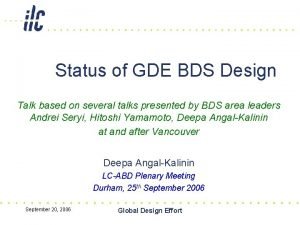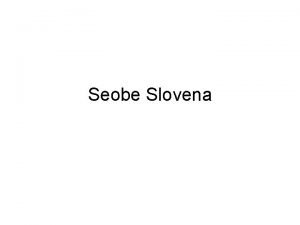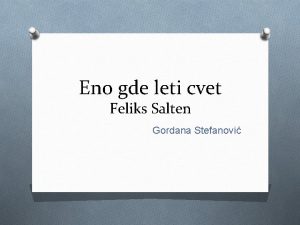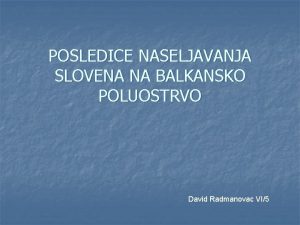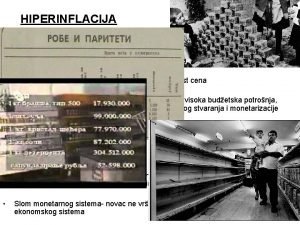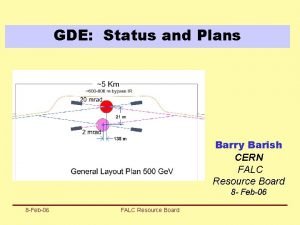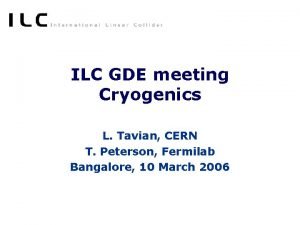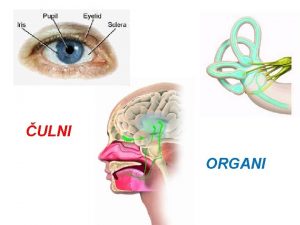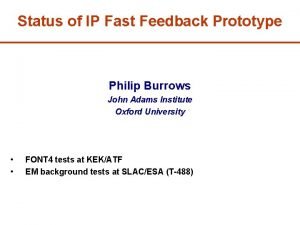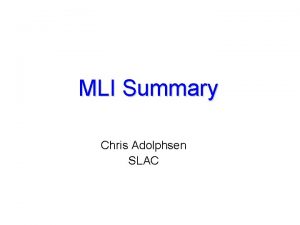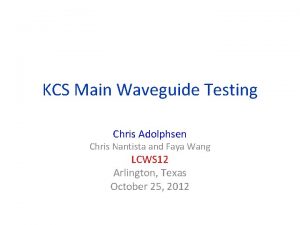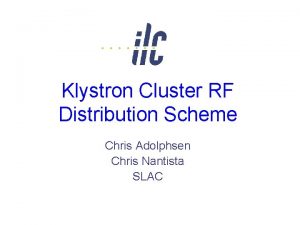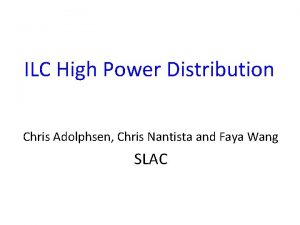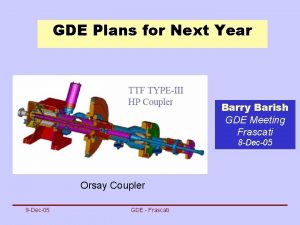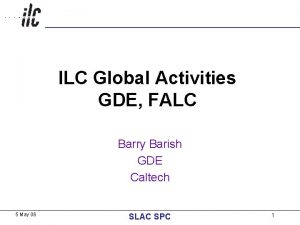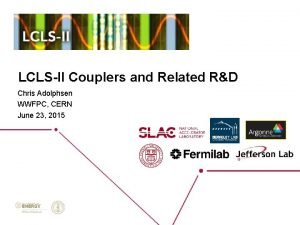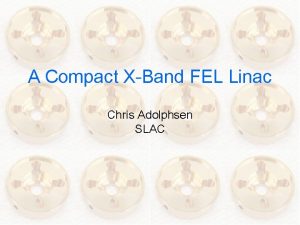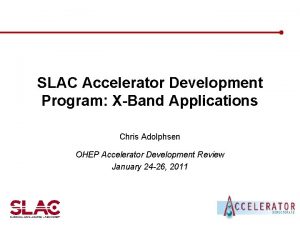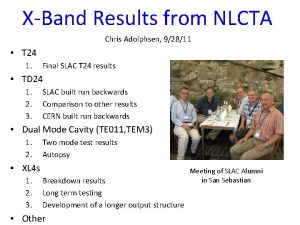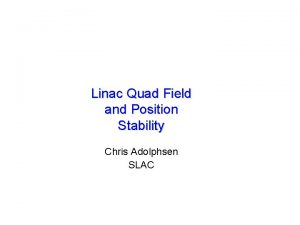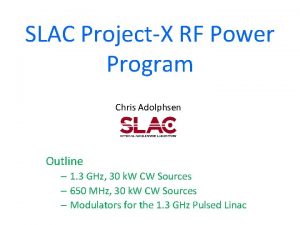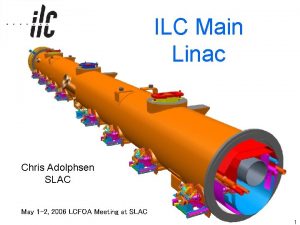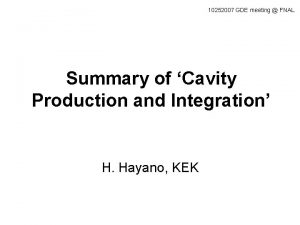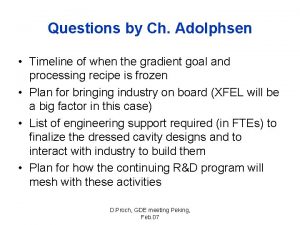Summary of MLI Studies Chris Adolphsen GDE Meeting


![End on view of coupler geometry (from downstream end) y [mm] Edge of irises End on view of coupler geometry (from downstream end) y [mm] Edge of irises](https://slidetodoc.com/presentation_image_h2/471e6938609cd5e5cec0177fe31931a3/image-3.jpg)


![Symmetrizing Couplers y [mm] rotated coupler hm-us fm-ds hm-ds x [mm] Z. Li proposes Symmetrizing Couplers y [mm] rotated coupler hm-us fm-ds hm-ds x [mm] Z. Li proposes](https://slidetodoc.com/presentation_image_h2/471e6938609cd5e5cec0177fe31931a3/image-6.jpg)



![Summary of RF Kicks (K Bane) SLAC <k> [V] krms [V] x y ZLi_x Summary of RF Kicks (K Bane) SLAC <k> [V] krms [V] x y ZLi_x](https://slidetodoc.com/presentation_image_h2/471e6938609cd5e5cec0177fe31931a3/image-10.jpg)






















- Slides: 32

Summary of MLI Studies Chris Adolphsen GDE Meeting at Sendai, 3/14/08

On Axis Wake Kicks (I. Zagorodnov, V Yakovlev, Z. Li and K. Bane) Detailed view of FM and HM couplers - note protrusion of couplers
![End on view of coupler geometry from downstream end y mm Edge of irises End on view of coupler geometry (from downstream end) y [mm] Edge of irises](https://slidetodoc.com/presentation_image_h2/471e6938609cd5e5cec0177fe31931a3/image-3.jpg)
End on view of coupler geometry (from downstream end) y [mm] Edge of irises (r= 35 mm) 30 mm fm-ds 39 mm hm-ds hm-us (fm—fundamental, hm—higher mode, ds—downstream, us—upstream) x [mm]

On-Axis Wake Due to Coupler Asymmetry Numerical calculations performed in 3 steps: couplers in beam pipe, cavity with couplers, multiple cavities with couplers (I. Zagorodnov) Wake varies along bunch; (kx, ky) are kicks averaged over beam; in calculations z= 1 mm (due to mesh limitations) • One set of couplers in beam pipe: (kx, ky) = (-21, -19) V/n. C; agrees well with analytical optical model with all elements at same z: (-21, -17) V/n. C • One cavity with couplers: (kx, ky) = (-11, -10) V/n. C; agrees well with a zindependent optical model with iris shadowing with all elements at same z: (-13, -7) V/n. C. • Periodic solution: (kx, ky) = (-7. 6, -6. 8) V/n. C/m (reached after 2 cavities) V. Yakovlev has also performed numerical calculations for 1 mm bunches that agree reasonably well (e. g. periodic solution ~-5 V/n. C/m)

V. Yakovlev’s Gdfidl Results For z= 0. 3 mm the mesh needs to be finer, and more cavities are needed to reach periodic solution (~6) => large computer resources needed Expectation is that the kick for the short bunch ~0. 3 times the kick for z= 1 mm • T. Weiland’s group is also working on this calculation
![Symmetrizing Couplers y mm rotated coupler hmus fmds hmds x mm Z Li proposes Symmetrizing Couplers y [mm] rotated coupler hm-us fm-ds hm-ds x [mm] Z. Li proposes](https://slidetodoc.com/presentation_image_h2/471e6938609cd5e5cec0177fe31931a3/image-6.jpg)
Symmetrizing Couplers y [mm] rotated coupler hm-us fm-ds hm-ds x [mm] Z. Li proposes rotating upstream coupler by 180 to reduce wake => For one cavity with couplers, optical model + iris shadowing: (kx, ky)= (-2. 5, 1. 2) V/n. C [was (-13, -7) V/n. C]

Effect on Beam Wake has two terms: an offset term and a slope term Offset: A constant driving term to the equation of motion generates a kind of dispersion => the closed orbit depends on (longitudinal) position in bunch; model: y’’ + y/ 2= e 2 N W(s)/E has solution y= 2 e 2 N W(s)/E + betatron oscillation(s) Particles will perform free betatron oscillation about different centers, depending on s; projected emittance will oscillate; no real wake effect; average emittance will increase due to energy spread (filamentation) and normal cavity wake Slope: Numerical results for 3 couplers in beam pipe, Wav~ 2. 4 V/n. C/mm/m; for periodic case should reduce a factor 2~3 to ~1 V/n. C/mm/m, which is a factor 20 smaller than the normal cavity wake, so can be ignored

Estimated Emittance Growth (analytical approximation) Let e. N = 3. 2 n. C, < >= 68 m, y = 2*10 -8 m. k [V/n. C/m] ( / 0)max ( / 0)final 20 3. 1 1. 03 5 1. 23 1. 02 2 1. 04 1. 003 Bottom Line: For periodic solution the wake due to coupler asymmetry should not be a problem; with Z. Li’s modification, the effect will be even less

Summary of RF Kicks (Z Li) Average over cavity pair Eacc = 35 MV/m, I_Beam = 0. 011 A, Qext ~3. 4 E 6 Accelerating Gradient = 31. 5 MV/m Head-tail: +- 1 sigma_z Kick unit: Volt X-centroid Y-centroid X-head-tail Y-head-tail -2106 -785 33 3. 5 TDR-M 761 2621 24 4 TDR, TDR-Rot. X 609 -739 20 0. 3 TDR-M, TDR-M-Rot. X 664 2606 11 ~0 TDR-M, TDR-M-Mirror. Z 664 15 11 4 TDR M = TDR with 180 deg rotation of HOM on non-FPC end Rot. X = TDR rotated about x axis by 180 so FPC switches from up-stream to down-stream end and power feed direction changes. Mirror. Z = Up/Down end groups interchanged, power feed direction unchanged
![Summary of RF Kicks K Bane SLAC k V krms V x y ZLix Summary of RF Kicks (K Bane) SLAC <k> [V] krms [V] x y ZLi_x](https://slidetodoc.com/presentation_image_h2/471e6938609cd5e5cec0177fe31931a3/image-10.jpg)
Summary of RF Kicks (K Bane) SLAC <k> [V] krms [V] x y ZLi_x ZLi_y FNAL <k> [V] krms [V] -2000 17. -3320 18. -670 2. 7 -230 2. 9 -650 13. -1020 16. -2490 1. 8 -2810 4. 6 Average and rms of rf kicks experienced by the beam, according to SLAC and FNAL calculations. Here we assume Vacc= 31. 5 MV/m and z= 0. 3 mm. Given are the total kicks due to all couplers in one cavity as is, and also after Z. Li’s symmetrization (the upstream coupler is rotated by 180 deg).

Beamline Absorber Study Using T 3 P 1. Application (ILC, XFEL, ERL, …); 2. Simulation method (T 3 P); 3. Simulation results; 4. (3 D one TESLA cavity with couplers, 2 D one cavity/two-cavity/three-cavity. . ) 5. 4. Going to simulate multi-cavity with short bunch and taking account into dispersive medium; Liling Xiao

Monopole Single Passage Losses for three cavities without couplers One bunch Q=3. 2 nc, bunch length=10 mm Loss factor (V/pc)=9. 96 V/pc Lossy dielectric conductivity σeff=0. 6(s/m) Dielectric constant εr=15, within 80 ns Total Energy Generated by Beam (J) 10. 208 e-5 Energy propagated into beam pipe (J) 4. 44 e-6 Energy dissipated in the absorber (J) 7. 0 e-7 Energy loss on the Non SC beampipe wall (J) around absorber 9. 3 e-10 Energy loss in intersection between two cavities (J) 1. 3 e-9 (cold copper conductivity=3500 e 6 Simm/m)

Ratio of Dissipated Energy and Propagated Energy to Total HOM Energy 1 -cavity+absorber @200 ns 1 -cavity+absorber @80 ns 2 -cavity+absorber @80 ns 3 -cavity+absorber @80 ns left beampipe 14. 1% 12. 4% 8. 9% 6. 6% right beampipe 11. 3% 10. 3% 6. 0% 4. 5% absorber 2. 6% 2. 1% 1. 8% 1. 7% Total 28. 0% 24. 8% 16. 7% 12. 8% Absorber fraction 9. 4% 8. 5% 10. 8% 13. 5% Beam Pipe Total for 3 -cavity CM = 1. 3 e-9 * 2800 * 5 / ( 0. 128 * 0. 135) = 1. 1 m. W Worse case for 8 -cavity CM and 300 um bunch = 1. 1 * (8/3) * (10/0. 3) = 100 m. W

E-Field Strength at TTF 3 Cold Coupler Window Region Lixin Ge, ACD Group at SLAC

Model E magnitude red is window

1 2 3 4 5 E amplitude along y axis

TTF HOM Measurement Data Analysis with Curve Fitting Method Shilun Pei with Chris Adolphsen, Zenghai Li, Karl L. Bane, et al. SLAC, Feb. 27, 2008

Steering setup Module ACC 4 BPM 18 BPM 17 2007 -01 -22 T 091106. mat

Modal Analysis of Dipole Signals Real Im Amp Fit frequency spectrum near 1. 7 GHz to sum of complex Lorentzians Derive frequency and Q of two polarizations from simultaneous fit to 36 orbits

Cavity Freq in ACC 3/ACC 4/ACC 5 2007 -01 -22 T 091106 Two cavities with largest mode splitting ACC 3 ACC 4 ACC 5

Cavity Q in ACC 3/ACC 4/ACC 5 2007 -01 -22 T 091106 ACC 3 ACC 4 ACC 5

Fit of Amplitudes to BPM X and Y • Ignoring the small out-of-phase (angle) contributions, the resulting mode amplitudes correlate well with the x and y positions inferred from the bpm data

Mode Polarizations 2007 -01 -22 T 091106, ACC 4 CAV # Mode 1 Pol. Angle Mode 2 Pol. Angle 2 3. 03 o 92. 70 o 4 21. 62 o 111. 27 o 5 2. 85 o 94. 29 o 6 4. 10 o 93. 68 o 7 -15. 01 o 72. 47 o 8 -23. 76 o 68. 77 o

S-Band RF BPM Signal Simulations Johnny Ng

RF Distribution Module Cold Test load VTO 2 1 load 4 window circulator 3 hybrid phase shifter turned for visibility The first (of 4) 2 -cavity module of our RF power distribution system for Fermilab’s first NML cryomodule is assembled and cold tested and ready for high-power testing. It incorporates: SLAC VTO and hybrid IBFM window (for pressurization of high-power volume) S. P. A. Ferrite isolators and loads Mega bends and flex guides (and dir. cplrs. while awaiting S. P. A. pieces) C. Nantista

VTO set for 2 nd to last cavity pair (~3 d. B). COLD TEST RESULTS: S 11 = -43. 0 d. B (0. 005%) S 21 = -2. 948 d. B (50. 72%) POWER 2. 36% of power missing (-0. 104 d. B) Pair power division equal to within 1%. Slightly more than ½ power sent through to allow for downstream losses. Expect roughly: S 31 = -6. 318 d. B (23. 35%) S 41 = -6. 276 d. B (23. 57%) Bends: VTO: Window: 0. 493 0. 088% = Hybrid: 0. 493 0. 42% = Circulators: 0. 493 1. 78% = Phase shifters: 0. 493 0. 55% = Flex guides: 0. 62% + 0. 493 0. 62% = PHASE 0. 41% 0. 446% 0. 043% 0. 207% 0. 878% 0. 271% 0. 926% ~3. 18% Phases of S 31 and S 41 initially within 1. 7° of each other (adjustable with phase shifter). Module through phase error = ~-6. 7° (easily absorbed in next modules phase shifters). SPACING Feed spacing measures ~1. 3827 m, compared to 1. 3837 m coupler spacing. Module length measures ~2. 7674 m, exact to measurement resolution. C. Nantista

Simulation of Cavity Pair Coupling Through Hybrid w/o Circulators Individual Cavity Gradients Assumed identical cavities and lossless, symmetric coupling network with equal coupling but imperfect port isolation. Net Pair Acceleration f=0 |S 23| = 0: -40 d. B: -30 d. B: -20 d. B: black blue cyan green black blue & red cyan & magenta green & yellow f = p/4 f is the phase length from the hybrid ports to the cavities (with S 23 set to 0). |S 23| = 0: -40 d. B: -30 d. B: -20 d. B: black blue & red cyan & magenta green & yellow Typical measured isolation: -42— 48 d. B → gradient variation << 0. 1% C. Nantista

ILC Positron Capture Cavity Prototype Goal: Power with 5 MW, 1 msec pulses to produce 15 MV/m gradient Faya Wang

RF waveforms are calibrated in these cases Normal Off Hard Events Breakdown in Waveguide Soft Events Breakdown in Cavity

Breakdown Data During Processing Rate (1/hr) vs Time (hr) Fraction of Hard and Soft Events vs Time (hr) Distribution of Time Between Breakdowns for Different Processing Periods F. Wang

Temperature vs Cavity Input Power (with 28 gpm cooling) Cavity Detuning vs Temperature (slope near that expected)

Cavity Gradient Measurements with Beam (Worlds first L-band cavity operation in an X-band Linac)
 Jcl coding sheet
Jcl coding sheet Master leren en innoveren fontys
Master leren en innoveren fontys Ib music doc
Ib music doc Paradigm shift from women studies to gender studies
Paradigm shift from women studies to gender studies For todays meeting
For todays meeting Proposal kickoff meeting agenda
Proposal kickoff meeting agenda What is meeting and types of meeting
What is meeting and types of meeting Types of meeting
Types of meeting Gde status
Gde status Prapostojbina
Prapostojbina Vlaska nizija karta
Vlaska nizija karta Que es gde
Que es gde Ekurhuleni north district website
Ekurhuleni north district website Department of education revised curriculum 2020
Department of education revised curriculum 2020 Eno gde leti cvet
Eno gde leti cvet Unutrasnji i centralni dinaridi
Unutrasnji i centralni dinaridi Sta je trajcov ligament
Sta je trajcov ligament Gde vision and mission
Gde vision and mission Gde vision and mission
Gde vision and mission Glavni grad dubaija
Glavni grad dubaija Ravnica posavina
Ravnica posavina Samov savez
Samov savez Menicni blanket
Menicni blanket Gde zameniti stare funte
Gde zameniti stare funte Gde zameniti stare funte
Gde zameniti stare funte Gde status
Gde status Na kom kontinentu se nalazi egipat
Na kom kontinentu se nalazi egipat Acd cryogenics
Acd cryogenics Bambi i falina
Bambi i falina Falina bambi
Falina bambi Gradja puza
Gradja puza Gde
Gde Global digital exemplars
Global digital exemplars








